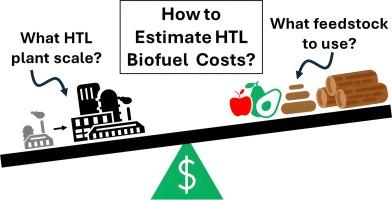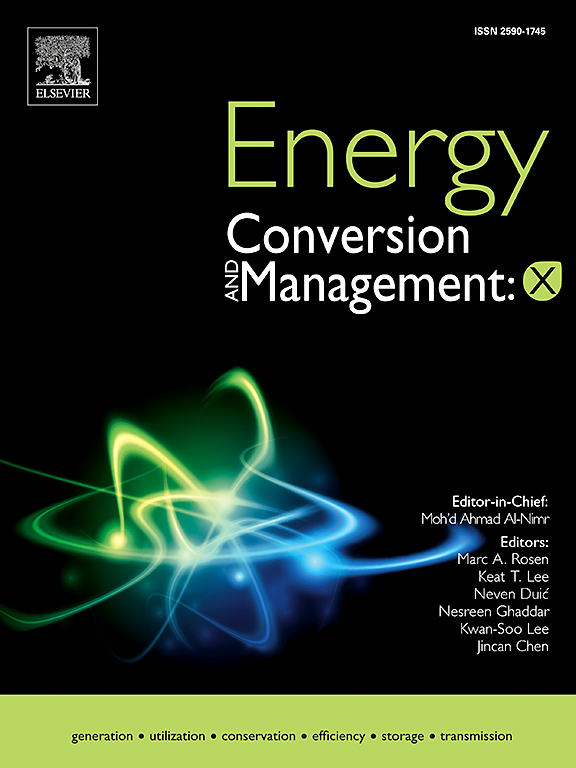One techno-economic analysis to rule them all: Instant prediction of hydrothermal liquefaction economic performance with a machine learned analytic equation
IF 7.1
Q1 ENERGY & FUELS
引用次数: 0
Abstract
Hydrothermal liquefaction (HTL) has remarkable potential for efficient conversion of abundant, decentralized organic wastes into renewable fuels. Because waste is a highly distributed resource with context-dependent economic viability, selection of optimal deployment sites is slowed by the need to develop detailed techno-economic analyses (TEA) for the thousands of potential deployment locations, each with their own unique combinates of scale, proximity to infrastructure/markets, and feedstock properties. An economic modeling framework that requires only easily obtainable inputs for assessing economic performance would therefore allow multiplexed analysis of many thousands of cases, whereas traditional TEA would not be possible for more than a handful of cases. Within such a context, the present study uses machine learning to guide development of a TEA and modeling framework which provides accurate cost predictions using three key inputs – feedstock cost, biocrude yield, and process scale – to estimate the minimum fuel selling price (MFSP) that an HTL process can achieve. The structure of the proposed framework is informed and based on empirical observations of cost projections made by a detailed TEA over a wide range of feedstock costs, biocrude yields, and process scales. A machine learning guided process was used to identify, train, and test a series of models using auto-generated data for training and independently reported data for testing. The most accurate model consists of three terms and requires 6 adjustable parameters to predict independently published values of MFSP (N = 28) to within an average value of ± 20.4%. It is demonstrated that the reduced-order model’s predictions fall within 40% of the corresponding published values 95% of the time, and in the worst case, the associated discrepancy is 45.9%, suggesting that the accuracy of the machine learned model is indeed comparable to the TEAs that were used to build it. Moreover, the terms in the model are physically interpretable, conferring greater reliability to the use of its predictions. The model can be used to predict the dependence of MSFP on biocrude yield, scale, and feedstock cost; interestingly, MFSP is insensitive to biocrude yield and/or scale under many situations of interest and identifying the critical value for a given application is crucial to optimizing economic performance. The proposed model can be also extended to evaluate economic performance of newly developed HTL-based processes, including catalytic HTL, and the methodological framework used in this study is deemed appropriate for the development of machine learned TEA models in cases of other similar waste-to-energy technologies.

一个技术经济分析就能解决所有问题:用机器学习的分析方程即时预测热液液化的经济效益
水热液化技术(HTL)在将丰富、分散的有机废物高效转化为可再生燃料方面潜力巨大。由于废物是一种高度分散的资源,其经济可行性取决于具体情况,因此在选择最佳部署地点时,需要对数千个潜在部署地点进行详细的技术经济分析(TEA),而每个地点都有自己独特的规模、与基础设施/市场的距离和原料特性。因此,经济建模框架只需要容易获得的投入来评估经济效益,就可以对成千上万个案例进行多重分析,而传统的技术经济分析只可能对少数几个案例进行分析。在这样的背景下,本研究利用机器学习指导开发了一个 TEA 和建模框架,该框架利用三个关键输入(原料成本、生物原油产量和工艺规模)提供准确的成本预测,以估算高温液化工艺可实现的最低燃料销售价格(MFSP)。拟议框架的结构是根据详细的 TEA 在广泛的原料成本、生物原油产量和工艺规模范围内对成本预测的经验观察得出的。在机器学习的指导下,使用自动生成的数据进行训练,并使用独立报告的数据进行测试,以确定、训练和测试一系列模型。最准确的模型由三个项组成,需要 6 个可调参数,可预测独立公布的 MFSP 值(N = 28),平均值为 ± 20.4%。结果表明,减阶模型的预测值在 95% 的情况下都在相应公布值的 40% 以内,在最坏的情况下,相关差异为 45.9%,这表明机器学习模型的准确性确实可与用于构建该模型的 TEA 相媲美。此外,该模型中的术语是可以物理解释的,这为其预测结果的使用提供了更大的可靠性。该模型可用于预测 MSFP 对生物原油产量、规模和原料成本的依赖性;有趣的是,在许多相关情况下,MFSP 对生物原油产量和/或规模并不敏感,而确定特定应用的临界值对于优化经济效益至关重要。所提出的模型还可扩展用于评估新开发的基于 HTL 的工艺(包括催化 HTL)的经济性能,本研究中使用的方法框架被认为适合于在其他类似废物变能源技术中开发机器学习 TEA 模型。
本文章由计算机程序翻译,如有差异,请以英文原文为准。
求助全文
约1分钟内获得全文
求助全文
来源期刊

Energy Conversion and Management-X
Multiple-
CiteScore
8.80
自引率
3.20%
发文量
180
审稿时长
58 days
期刊介绍:
Energy Conversion and Management: X is the open access extension of the reputable journal Energy Conversion and Management, serving as a platform for interdisciplinary research on a wide array of critical energy subjects. The journal is dedicated to publishing original contributions and in-depth technical review articles that present groundbreaking research on topics spanning energy generation, utilization, conversion, storage, transmission, conservation, management, and sustainability.
The scope of Energy Conversion and Management: X encompasses various forms of energy, including mechanical, thermal, nuclear, chemical, electromagnetic, magnetic, and electric energy. It addresses all known energy resources, highlighting both conventional sources like fossil fuels and nuclear power, as well as renewable resources such as solar, biomass, hydro, wind, geothermal, and ocean energy.
 求助内容:
求助内容: 应助结果提醒方式:
应助结果提醒方式:


